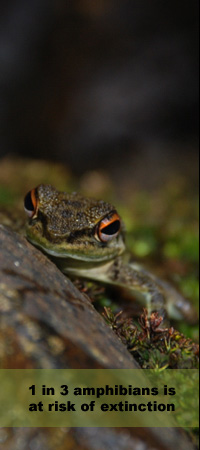|
Amphibians have existed on earth for about 300 million years, yet within the last several decades more than 120 species are thought to have disappeared for ever because of human activities.
Amphibian populations have declined dramatically around the world since the 1950s even in virgin parts (e.g., national parks). This pervasive decline is the results of local, regional, and global human induced causes. In 2006, a total of 442, 738, and 631 amphibian species were classified as critically endangered (imminent risk of extinction), endangered (very high risk of extinction in the wild), and vulnerable (facing a high risk of extinction in the wild). Overall, 1 in 3 amphibians are at risk of extinction!
Local impacts
These impacts include habitat modification, amphibian collection, and non-native species introduction. Habitat modification can be divided into three types: habitat destruction, habitat fragmentation, and habitat degradation.
Regional impacts
These impacts include habitat modification, amphibian collection, and non-native species introduction. Habitat modification can be divided into three types: habitat destruction, habitat fragmentation, and habitat degradation.
Global impacts
These impacts include environmental estrogens, climate change, and diseases (e.g. fungus Batrachochytrium dendrobatidis).
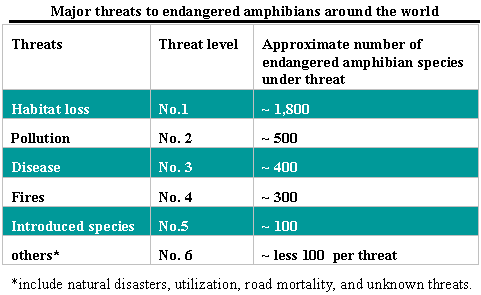
Data from IUCN, Conservation International, and NatureServe. 2006. Global Amphibian Assessment
Endangered amphibian species are found near all over the planet (Table 2), however, some regions of the world have been more affected than others. The worst places include Haiti, montane southeastern Chiapas, Mexico through central Guatemala, montane Costa Rica and western Panama, the Andes of Colombia and Ecuador, and the central portion of the Atlantic Forest in eastern Brazil.
At the regional scale, amphibians in the Caribbean are most threatened (84% of the regionís 171 species) due to high habitat loss, followed by Mesoamerica (685 species) , South America (2,065 species), and North America (262 species).
Countries with the highest number of threatened amphibians (more than 100 amphibians per country) include Colombia (209), Mexico (196), Ecuador (163), and Brazil (110).
Distribution of Threatened Amphibians in Central America, Northern South America, and the Caribbean

Data from IUCN, Conservation International, and NatureServe. 2006. Global Amphibian Assessment
Table 2. Examples of worldwide critically endangered amphibians

Data IUCN 2006
Continue on page 5
|
|
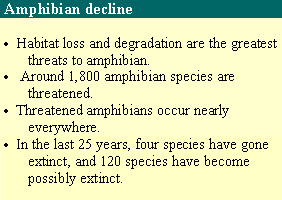
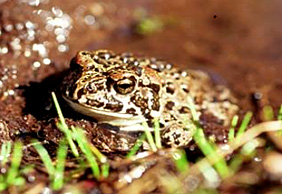
The Yosemite toad (Bufo canorus) is an endangered amphibian from the Sierra Nevada, California, USA. © 2004 Pierre Fidenci
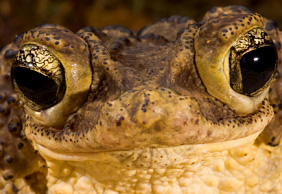
The critically endangered Puerto Rican crested toad (Bufo lemur) occupies mostly rocky limestone outcrops of Puerto Rico and the Virgin Gorda Island. © 2006 Paddy Ryan

The critically endangered Chinhai salamander (Echinotriton chinhaiensis) lead a largely hidden terrestrial life. © 1999 Max Sparreboom
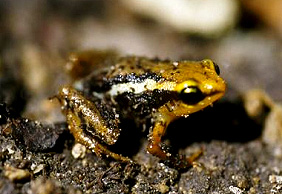
Rarely observed the critically endangered Baracoa dwarf frog (Eleutherodactylus orientalis) from Cuba is one of the smallest frog in the world. © 2004 Pierre Fidenci
|

